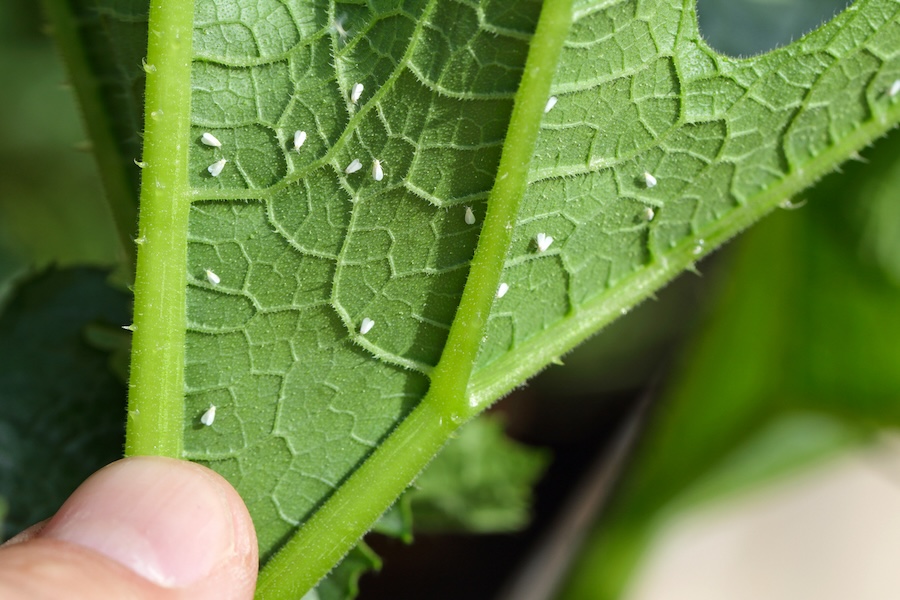Jan 15, 2024UGA leads research into silverleaf whiteflies with USDA
In 2017, an outbreak of a small, white bug — about a millimeter in size — swept through south Georgia, causing widespread damage totaling more than $150 million to the vegetable industry that year.
Now fully established throughout the state, silverleaf whiteflies (Bemisia tabaci) have proven to be a persistent threat to numerous economically important crops, causing direct damage through feeding, and transmitting more than 100 plant viruses.
These insects are “true bugs,” as entomologists call them, more related to aphids than to flies. As a true bug (or Hemipteran) they have piercing mouthparts used to feed by sucking sap from inside the leaf. They may be small, but they are a major pest.
New research on a persistent pest
A multidisciplinary team of researchers in the University of Georgia College of Agricultural and Environmental Sciences (CAES) recently renewed a $4 million contract with the USDA-Agricultural Research Service (ARS) to build upon their previous work. The team aims to better understand this emerging pest and develop targeted interventions to mitigate the impact of whiteflies on vegetable production in the Southeast.
Allen Moore, a distinguished research professor in the UGA Department of Entomology, leads the multi-institutional team of researchers from UGA, Fort Valley State University and Auburn University in collaboration with USDA ARS in Charleston, South Carolina.
While this pest has been around for several years, the industry still faces an emergency as whiteflies are notoriously difficult to control, Moore said.


He explained that with a combination of warmer winter temperatures, a wide host range and the ability to reproduce asexually, whitefly populations increase rapidly. Additionally, very few crop varieties are resistant to whiteflies and the viruses they carry. Scouting for the insect is time-consuming, as they’re mostly only found on the underside of leaves, further complicating the effective use of insecticide applications.
While traditional pest management strategies use insecticide applications early and often to help knock back populations, in the case of whiteflies, the practice is extraordinarily expensive and is becoming less effective.
“It’s the worst pest you can possibly imagine,” Moore said. “Adults with insecticide-resistance genes survive and pass the trait to their offspring. As more susceptible whiteflies are eliminated from a population, the proportion of resistant insects increases, leaving less opportunity for traditionally effective insecticides to do their intended job.”
IPM provides an array of effective tools
To respond to this dynamic nature and the imperative to develop effective management strategies, the research team is focused on finding integrated pest management (IPM) solutions that combine the use of cultural practices and chemical and biological controls to diversify interventions and improve strategic planning before the planting season.
The team’s effort has focused on identifying short-term solutions to meet farmers’ immediate needs and investing in medium- and long-term projects to form the comprehensive understanding required to make holistic, sustainable management decisions in the future.
For example, the team is evaluating both the role of insecticides and how insecticide resistance might evolve in response to insecticides. Diamide and neonicotinoid insecticides remain the cornerstone of whitefly management in vegetable crops. Researchers at UGA used molecular RNA-seq and RNAi to understand genetic mechanisms behind resistance to these common insecticides and to identify the genes involved. The long-term goal is to develop control strategies that are informed by how resistance evolves.
More immediate control may come from using integrated pest management techniques. The team at Auburn has developed row-cover products that reduce whitefly pressure. They have found that silver covers improve yield and insecticide efficacy. Team members at UGA have examined the relationship between weather and whitefly outbreaks and have found that water availability was a major factor for outbreaks, providing additional tools for management.
Overall, the research program is designed to attack the whitefly problem from multiple angles. In addition to developing new control products, the researchers are investigating solutions such as potential plant resistance to viruses transmitted from whiteflies, ways to exploit our increased understanding of whitefly population biology and ecology, and finding biotechnological solutions to whitefly management.
Team science moves research along
Perhaps most importantly, Moore said the unique approach of this research collective is the implementation of team science — a diverse research group communicating in tandem, problem-solving together.
“It’s not a geneticist working alone in the laboratory, it’s not the field biologist working alone in the field, it’s bringing everyone together all at once and talking to each other and trying to build off what each other understands,” he said. “This work isn’t being done in isolation, we are making more rapid progress by working as a collective than as individual researchers.”
Thinking about their long-term goals, Moore added that building the foundational research now is key to resolving the problem in the future.
“We can leverage our combined expertise in genomics, molecular genetics, basic physiology, and understanding how insecticide resistance evolves because we have the tools to do it. The hope and expectation are that by doing it as an integrated team, we will get further along faster.”
— Emily Cabrera is a writer and public relations coordinator for the College of Agricultural and Environmental Sciences at the University of Georgia.
Top photo: Due to a combination of warmer winter temperatures, a wide host range and the ability to reproduce asexually, whitefly populations increase rapidly. Photo courtesy of the University of Georgia.















